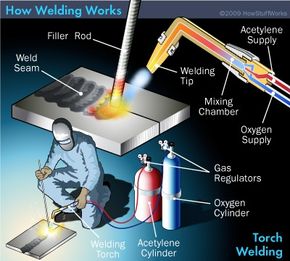The Process of Welding
We're all suited up and ready to start welding. Most welding done today falls into one of two categories: arc welding and torch welding.
Advertisement
Arc welding uses an electrical arc to melt the work materials as well as filler material (sometimes called the welding rod) for welding joints. Arc welding involves attaching a grounding wire to the welding material or other metal surface. Another wire known as an electrode lead is placed on the material to be welded. Once that lead is pulled away from the material, an electric arc is generated. It's a little like the sparks you see when pulling jumper cables off a car battery. The arc then melts the work pieces along with the filler material that helps to join the pieces.
Feeding the filler into the welding joint takes steady hands and an eye for detail. As the rod melts, the welder must continuously feed the filler into the joint using small, steady, back-and-forth motions. These motions are what gives welds their distinctive appearance. Going too fast or slow, or holding the arc too close or far away from the material can create poor welds.
Shielded metal arc welding (SMAW or stick welding), gas metal arc welding (more commonly known as metal inert gas, or MIG, welding) and gas tungsten arc welding (frequently called tungsten inert gas, or TIG, welding) all exemplify arc welding.
These three common methods each offer unique advantages and drawbacks. Stick welding, for instance, is inexpensive and easy to learn. It's also slower and less versatile than some other methods. Oppositely, TIG welding is difficult to learn and requires an elaborate welding rig. TIG welding produces high-quality welds, however, and can weld materials that other methods can't.
Torch welding represents another popular welding method. This process typically uses an oxyacetylene torch to melt the working material and welding rod. The welder controls the torch and rod simultaneously, giving him or her a lot of control over the weld. While torch welding has become less common industrially, it's still frequently used for maintenance and repair work, as well as in sculptures (more on that later).
